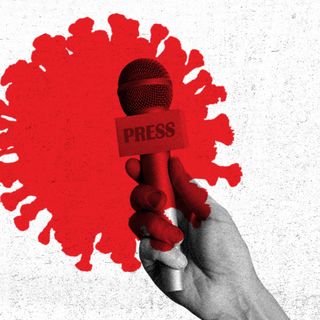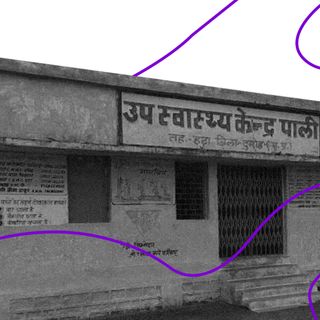
Why People Who Self‑Harm Struggle To Quit
Injuring oneself not only provides a sense of control but also releases endorphins that induce a sense of euphoria.

As an individual who began self-harming at 15, over the years, I’ve made several promises to resist giving in to my urges — and broken several of these promises. The longest I’ve gone without cutting myself is, perhaps, two years. But the moment I cut myself again during a moment of unbearable emotional turbulence, I suddenly find myself slipping into old patterns, where one cut becomes many, and self-harm becomes my go-to at the slightest of emotional triggers.
Called non-suicidal self-injury, or NSSI, the act of deliberately inflicting damage on one’s body is, by definition, non-suicidal, but it is still quite often equated with suicidal behavior. Until 2013, self-harm was simply treated as a symptom of underlying mental disorders — now, it is considered a “distinct clinical phenomenon” by the fifth Diagnostic and Statistical Manual, commonly known as the DSM-5. With rising awareness of the prevalence of self-harm in the global population, investigations into the phenomenon are growing. In recent years, studies seeking to explore whether self-injury constitutes addictive behavior have also emerged. Although the results have mostly been inconclusive so far, the question of what makes it so difficult for people to quit self-harm behavior remains.
Amid the ongoing mental health crisis brought on by the global pandemic, professionals have reported a surge in self-harming behavior — not just among adults, but also among children, some as young as 8. With more and more people resorting to the habit, it has become even more imperative than before to understand the motivations behind self-injury and why such a painful habit keeps people coming back for more.
Injuring oneself can be a way to ‘feel something’ when one is experiencing emotional numbness, or a way to distract oneself from an ongoing phase of unbearable emotional turbulence, by directing one’s focus to a physical injury.
For some, it can also be a way to draw attention to one’s suffering and seek help — especially if one is unable to verbalize their needs. O., 27, who started self-harming around the time she was 11, says she resorted to falling down deliberately or hitting herself to get people to give her attention and care about her. “I felt that if I wasn’t [physically] hurting, people wouldn’t care about me,” she says. She was bullied as a child, and spent a socially isolated childhood with “no friends,” she says In hindsight, she says she tried to use self-harm to cope with her loneliness.
Self-injury can serve as a positive reinforcement for some and a negative reinforcement for others, depending on their motivation. In behavioral psychology, reinforcements act as motivational tools. In O.’s case, the care and attention of people around her acted as positive reinforcements. On the other hand, a negative reinforcement encourages a behavior by helping one get rid of undesirable elements — in the case of many, including myself, that element is emotional angst. And any reinforcement, as the word suggests, can strengthen one’s resolve to engage in certain acts, leading to an increase in their frequency.
Another motivating factor behind engaging in self-harm, and continuing with it, is the element of control the behavior engenders. “Unlike emotional or social pain, it’s possible to control physical pain,” Joseph Franklin, a psychologist at Florida State University, explains. Either by choosing the mode of self-harm, regulating the force of the injury, or both, one can control the extent of physical pain one inflicts upon oneself. This sense of control in a moment of helplessness and emotional turbulence can add to its appeal as a coping mechanism.
Related on The Swaddle:
Teenage Girls Experience Worse Mental Health and Self‑Harm More Than Boys: Study
But rather than being a one-off moment of emotional release, self-harm often becomes a cycle. R., 25, “had suicidal thoughts and urges” since he was in fourth grade, but he cut himself for the first time in 2019. Since then, he has lost count of how many times he’s harmed himself after conflicts and during episodes of severe depression. “I wanted to die, so self-harm made me feel closest to death,” he says. He still struggles with the urge to hurt himself with a knife, but says he has been able to resist it for almost six months now.
Despite deciding to stop, sometimes people simply can’t. “I vowed never to do it again. Within two weeks, I had broken that vow. … I don’t enjoy the process, nor do I like the scars. It’s shameful and embarrassing. I desperately wanted to stop, but one thing kept getting in my way: after I cut, I felt better,” Carrie Arnold, a journalist, writes in Aeon of her experience with self-harm.
A., 35, too, has tried to stop harming herself, but she finds it difficult to resist the urge “when things get complicated and troubling and difficult to deal with, and I can’t figure a way out.”
The same part of the human brain senses both emotional and physical pain. Upon experiencing physical pain, the brain releases endorphins, which are chemicals produced by the body to relieve pain. They essentially lead to a euphoric state and reduce angst by working on this pain center in the brain. “… as the physical pain began to fade, it took some of my emotional distress with it,” Arnold writes.
Some people equate the aftermath of self-harm with the way they feel after an intense cry. “Just the moment after hurting myself, I feel calm. I get tired and I feel like lying and sleeping. It’s like the after-feeling of serious crying,” R.D., 24, says. And she’s right: crying, too, leads to the release of endorphins, just like physical injury does.
Endorphins are sometimes called the “natural opiates” of the human body. Their effect is comparable to the class of drugs that also relieves pain, produces a feeling of euphoria, and is addictive. Experts note that the natural high induced by endorphins can lead self-injury to assume the form of addiction-like behavior — though not exactly and not always an addiction.
Resulting from emotional dysregulation, self-harm can assume the form of a “maladaptive coping behavior,” in the absence of any other form of release, according to Taruna Jamalamadaka, D.Clin.Psy., a clinical psychologist from the U.K. But unlike addictions, the craving, here, isn’t for the substance or even for the act of cutting — it’s for the emotional release, she explains. In fact, even in cases of substance abuse, which is also a form of self-harm per se, clinicians try to distinguish whether it is indeed an addiction or yet another maladaptive coping mechanism. “It’s a tough distinction to make,” she notes.
In her practice, Samriti Makkar Midha, a Bombay-based psychotherapist, prefers to look at self-harm through the lens of an “unhealthy coping strategy, than an addictive behavior.” However, she notes, self-harm can mirror an addiction in cases where one’s threshold for physical pain rises, leading them to intensify the pain either by cutting themselves multiple times or by inflicting deeper cuts to get the same emotional relief. But since self-harm doesn’t exist in isolation and is generally a marker of underlying emotional turbulence, she is cautious about terming it as an “addiction.”
Related on The Swaddle:
Suicidal Thoughts Exist on a Spectrum — And Sometimes Involve No Active Plans to Die
In fact, researchers have attempted to find out whether self-injuries can be curbed in people by blocking the release of endorphins in their body, by using drugs commonly used to treat addictive behaviors — but, so far, the studies have not yielded any compelling results.
The accessibility of self-harm as a coping mechanism also makes it difficult for people to fall out of the habit, especially when they’re undergoing emotional turbulence. As an article on self-harm in The New York Times stated: “[Self-injury] can be summoned anytime, without permission or payment.” From knives simply lying around in kitchens, or razor blades easily available in bathrooms and on dressers, self-harm is always within reach — comparatively more so than substances like alcohol or drugs.
One way to break the cycle is to seek help — either from a professional, or sometimes, simply from a loved one. While O. has discussed her inclination to self-harm with her therapist, R.D. has discussed it with her partner, which they believe has helped them contain their urge to self-harm or at least has prevented them from acting on it.
But not everyone can access non-judgmental spaces to discuss their struggles with the result that acts of self-harm remain private, even shameful affairs. A. has tried opening up to people about her struggles, but says she wishes their reactions were more empathetic: “They don’t realize I’m tired, vulnerable, fragile — and I’m not able to get through this. Others would say, ‘You got to develop a tough skin, and you need to stay positive.'” Instead, she wishes for “a supportive environment … like how people have sponsors for individuals battling addiction, and other health issues.”
A.’s experience echoes mine. When I tried disclosing my urges to harm myself the first time, I was either called an attention-seeker, treated like I was crazy, or simply coddled to a point where people’s pity made me feel even more ashamed of my behavior. It wasn’t until I accidentally found people in college who shared similar struggles that I was able to look beyond the shame that shrouded episodes of self-harm and understand my own triggers better — enabling me to access help eventually.
While we’re caught in the eye of a rapidly escalating mental health crisis, with instances of self-harm already on the rise, perhaps, it’s time to de-stigmatize the act, and enable people to break out of their patterns — simply, by understanding where they’re coming from, without imparting judgment.
Devrupa Rakshit is an Associate Editor at The Swaddle. She is a lawyer by education, a poet by accident, a painter by shaukh, and autistic by birth. You can find her on Instagram @devruparakshit.
Related


Rural Health Centres Lack 76% Of Specialist Doctors They Need: Govt Report
